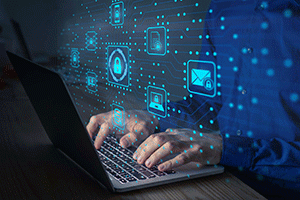

According to Fortinet’s 1H 2022 FortiGuard Labs Threat Landscape report [1], malicious cyber actors are experimenting with new attack vectors and increasing the frequency of zero-day and other attacks. They’re also stepping up the variety of their attacks. In the first half of 2022, the number of new ransomware variants we identified increased by nearly 100% compared to the previous six-month period.
The takeaway? Cybercriminals are showing no signs of slowing down. This increase in the volume and variety of attacks means there’s no better time to examine your existing security controls. Adopting a Zero Trust security model is more important than ever for organisations to reduce their risk and strengthen their security posture. Multi-factor authentication and universal Zero Trust Network Access (ZTNA) are two of the most useful technologies organisations can adopt to start integrating Zero Trust principles.
What is Zero Trust?
Organisations of all sizes are adopting Zero Trust as a corporate security strategy to enable digital acceleration, support remote and hybrid work, and reduce risk. A Zero Trust security model assumes that anything or anyone trying to connect to your network is a potential threat, so every user must be verified before permission is granted to access critical resources. This verification applies regardless of whether the user is trying to access those resources remotely or is already within the network perimeter, helping to ensure a stronger security posture for organisations with a hybrid workforce, in particular.
Zero Trust Network Access (ZTNA) takes the principles of Zero Trust and applies them to application access. Its per-session controls mean that users and devices are authenticated and monitored every time they seek to access an application, closing security gaps that can arise from things like unattended devices.
MFA: The foundation of ZTNA
Multi-factor authentication (MFA) is the foundation of new access control and monitoring solutions like ZTNA, and should be table stakes for all organisations across public and private sectors. It’s ideal for providing a more secure way to ensure that only authorised users gain access to the network resources they need, and is especially crucial in today’s work-from-anywhere (WFA) environment.
For many organisations, MFA is a must have, as mandated by regulations and compliance standards. All sectors benefit from combining MFA with a Zero Trust strategy, regardless of whether they’re required to do so due to compliance frameworks or government mandates. The healthcare industry – specifically tele-health – is a prime example. Many health organisations shifted to offering tele-health visits because of the pandemic. But to achieve this, these organisations were forced to revamp their security efforts to support and secure newly remote users and patients. Implementing a ZTNA strategy for tele-health workers that includes MFA has been foundational for keeping critical data, like patients’ personal information, secure.
The benefits of using MFA
Both organisations and users benefit from using MFA:
• Organisational benefits:
Increased protection against breaches:Security breaches often mean a loss of resources like data, time and money. MFA helps protect these valuable assets by ensuring only authorised users have access.
A safer remote work environment: With the move to WFA, employees are logging into their work devices at home, on the road, and everywhere in between. MFA gives your employees access to the systems and the data they need, while implementing appropriate security guardrails.
Defence in depth: MFA adds another layer of security to your organisation, providing enhanced protection against potential breaches.
• User benefits:
Identity protection: MFA offers a backstop if some of a user’s data falls into the wrong hands. Even if a username or password is compromised (accidentally or intentionally), that user’s overall security is still protected because criminals don’t have access to things like tokens or biometric data that are also required to gain access.
Data protection: Like identity protection, MFA makes it far more difficult for attackers to access a user’s identity and their associated data.
A safer remote work environment: With MFA, users can log into their devices from anywhere, confident that their identity and data are adequately protected. And because MFA can be software-based, users can stay productive and easily access the corporate network regardless of location.
[1] https://www.fortinet.com/content/dam/maindam/PUBLIC/02_MARKETING/08_Report/report-2022-H1-threat-landscape.pdf (or via the short link:www.securitysa.com/*fort3).

© Technews Publishing (Pty) Ltd. | All Rights Reserved.